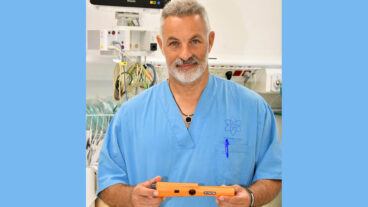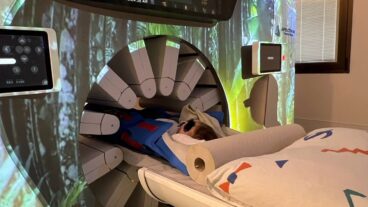Professor Eilon Vaadia and 10 PhD and MA students are researching one slice of a broader technology that, sometime in the future, may enable paralysis victims to bypass their damaged spinal cord.Were it not for the cruel fate of actor Christopher Reeve, who was paralyzed in a fall from a horse in 1995, it’s questionable whether scientists seeking ways to restore movement to victims of paralysis would be getting the considerable attention they are these days. But Reeve has boldly exploited his Superman celebrity to champion such endeavors around the world. And during a visit to Israel last summer, he met with neuroscientists from a number of institutions to learn about their work.
His interest did not end there. When professors Idan Segev and Eilon Vaadia, of the Hebrew University’s Interdisciplinary Center for Neural Computation (ICNC), flew to Miami in mid-January to report to the university’s American Friends on the center’s latest advances, Reeve took part in the event.
One project highlighted at that conference was Prof. Vaadia’s work on the reconstruction of movement, popularly dubbed “action from thoughts.” Vaadia, who is a physiologist, and 10 PhD and MA students are researching one slice of a broader technology that, sometime in the future, may enable paralysis victims to bypass their damaged spinal cord – the intermediary between the brain cells that determine movement and the muscles that effect it. A computerized device will replace the spinal cord, receiving electrical impulses emitted by the brain’s motor cortex, deciphering their “code” by means of an algorithm, and then relaying instructions to muscles or a robotic prosthesis, causing them to move in the appropriate way.
This doesn’t mean paralytics will be hauling PCs or laptops on their backs. “Computers are becoming faster and smaller,” Vaadia explains. “We’re thinking in terms of a computer small enough to implant under a patient’s skin. Implanting electronic gadgetry in the human body is already fairly widespread – heart pacemakers, for example. We’re hoping this technology will be applicable within the next decade.”
The “action from thoughts” technology may have other sophisticated applications as well. In the WIFI home of the future, signals may be sent to a computer instructing it to turn on the microwave, for example, so that dinner’s ready when you walk through the door. Vaadia hopes to extend this principle to enable a paralyzed patient, sitting in front of a PC or laptop, to use his thoughts to move the cursor on the screen to a box marked, “Turn on Light” or “Answer Speaker Phone” or, further in the future, “Activate Robot to Clean House.”
But that is the end of the process. The challenge to Vaadia’s lab is to master its start – deciphering the code of the brain’s electrical impulses. “Say you want to reach for a cup of coffee on your desk,” he posits. “To initiate that task, your brain computes the distance between your arm and the cup and plans the direction of the movement. Then the cells in the motor cortex start ‘firing’ – emitting electrical impulses. These impulses, called ‘spikes,’ are the coded instructions to the arm’s muscles on how to move in order to reach the cup.”
To decode them, the “spikes” must be captured and recorded in an electronically accessible way. Vaadia’s team does this by training a monkey to make a certain movement on demand – for example, to touch an object when a light goes on. As it is about to make this movement, the cells in its brain ‘fire’ and electrodes implanted in the motor cortex relay the resulting ‘spikes’ to a computer, which displays them on its monitor as lines of various heights. To decipher the code represented by these lines, the computer is programmed with an algorithm designed for this purpose by computational neuroscientists, and constantly revised – by a process of adaptive learning – to make its reading of the ‘spikes’ more accurate.
Vaadia and his students began their decoding effort two years ago. Today they are already able to predict a monkey’s arm movement just by analyzing the ‘spikes,’ without knowing what the animal was instructed to do. To illustrate this achievement, Vaadia turns to his computer and runs a series of graphic representations (imagine them as squiggles or doodles) of the monkey’s arm movements. One, for example, is upward and to the right; another circular; a third a combination of these two or an even more extensive, random movement. Alongside each of these squiggles, the computer then runs a graphic of how these movements were predicted by the scientists by analyzing the ‘spikes.’
Not all the predictions are 100 percent accurate yet. But the correlation between them and the monkey’s actual movement is already amazingly high. “And as we increasingly fine-tune the algorithm, we’re very optimistic that we’ll achieve far more accurate computations of these movements,” Vaadia says.
ICNC director Prof. Idan Segev observes that, “Once you’ve broken the basic code of these ‘spikes,’ you can use it to activate a robotic arm or, in principle, even a human arm, by wiring its muscles to a computer. Of course, we’re still quite a way from doing this.”
And developing this technology to work a robotic prosthesis, Segev gauges, is likely to succeed well before it can be applied to a human limb, “because the human arm and hand are far, far more complex than any robotic device.”
Still, he stresses, “the most difficult part of this research” – which is a combined biological, mathematical, computer-science, and engineering project – “is to understand the brain’s code for directing movement.” And today Vaadia and his students are already able to read that code by analyzing signals from as few as 30 brain cells (there are 50,000-100,000 cells in every cubic millimeter of the motor cortex).
Vaadia takes pains to stress that several other labs around the world are doing similar work, and it is the combination of their efforts – sometimes in collaboration, sometimes in competition – that is moving this field forward. Indeed, adds Segev, “The 21st century has been dubbed the century of the brain, because we expect great breakthroughs in neural research in the years to come, much of it as the result of an international collaborative effort.”
Yet in this case of Vaadia’s work, the collaboration starts right at home, within the ICNC itself.
VAADIA, who chairs the Physiology Department at the Hebrew University’s Faculty of Medicine, says he was always interested in the field now called neural computation and has been engaged in research on motor function for the past 15 years. “But Vaadia couldn’t have pulled off this latest, very complex project without input from experts in other fields,” explains Segev. This vital input is provided by other professors on the ICNC’s staff and, on a daily basis, particularly by the 10 graduate students working in Vaadia’s lab.
“The fundamental philosophy behind our interdisciplinary center – which is the second largest in the world devoted to brain research – is that you can’t understand a complex instrument like the brain if you approach it only as a biological phenomenon,” says Segev. “So our center is staffed by 24 professors in the fields of neurobiology and medicine, theoretical physics, applied physics and engineering, computer science, and psychology, all of whom engage in a give-and-take relationship with colleagues specializing in other fields.”
But it’s the center’s 60 PhD students – “the highest number of graduate students attached to any research center, in any field, in the world,” Segev reports – who make the greatest contribution to the day-to-day, step-by-step work on the center’s projects. And they stand out especially because they are being trained as multidisciplinary scientists.
“We professors tend to be bogged down in the traditions of our individual disciplines,” Segev admits. “But these students are a new breed of scientist. Originally schooled in one field – say philosophy or biology – as PhD students they become multidisciplinary by also studying additional fields, like mathematics, cognitive psychology and computer science.” By the time they get their PhDs, which takes six to seven years, “they’ve built up the most demanding and impressive CVs imaginable,” Segev attests proudly. “And often they’re immediately snatched up by the world’s most prestigious institutions – MIT, Berkeley, Stanford. Twenty of our former doctoral students are already scattered among leading universities abroad.”
The students in Vaadia’s lab, for example, originally studied biology, psychology, mathematics or computer science but are now expanding their ken by taking courses in other disciplines. “Nothing I’ve accomplished could have been done without these students and their interdisciplinary skills and mindset,” says Vaadia. The fact that all the center’s students study, work and meet together almost every day to exchange information – among themselves and with their professorial advisers – creates the optimal environment for fruitful research.”
Interdisciplinary research centers are a spreading phenomenon, Segev reports, and some 15 of them have adopted the model of the ICNC and approached it for direction. Future breakthroughs engendered by this new wave will, Vaadia and Segev confidently forecast, ease the plight of Reeve and countless fellow victims of paralysis and other neural-related maladies.
(Reprinted with permission from The Jerusalem Report – jsubs@jreport.co.il)












